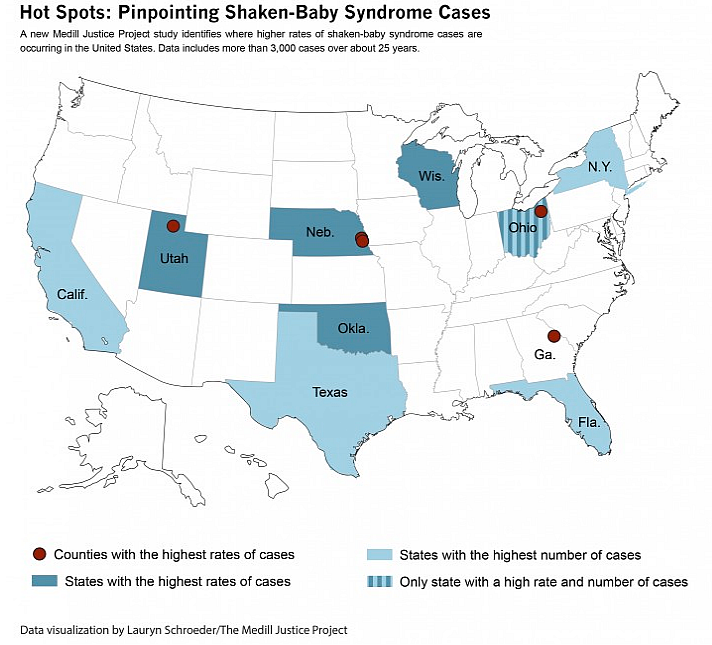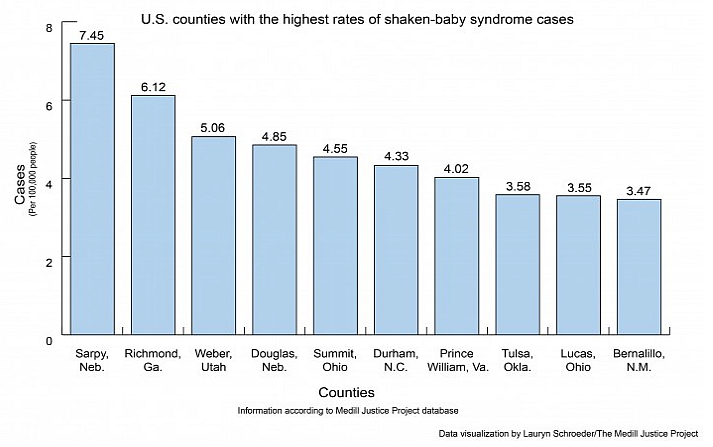Medill Database Opens With a Geography Lesson

National hot spots for reports of shaken baby syndrome
A year and a half after the Medill Justice Project made a public call for help building a database of shaken baby cases, the journalism-based innocence project has published a thin slice of its data, in conjunction with its analysis of how cases are distributed across the country. The view into the database is very narrow, but the county-by-county searches can be fascinating.
Collecting the data was a daunting task on its own, because there is no national mechanism for tracking either diagnoses or prosecutions of either shaken baby syndrome or the larger category of infant abusive head trauma. The diagnosis hit the headlines in 1997 with the trial of "Boston nanny" Louise Woodward, and it has become increasingly controversial since.
As Lauryn Schroeder writes on Medill’s SBS site, the rates of reported baby-shaking vary widely across the country. She offers a map of SBS hot spots and examines the situations in the states and counties with the highest concentrations, which seem to this reader to correlate with regional child-protection strategies that encourage police and hospitals to work together. The county that prosecuted immigrant father Hang Bin Li last year, for example, makes Schroeder’s list:
Queens County, N.Y., which lies southeast of Manhattan, has the 10th largest population by county in the United States and ranks third in the nation for total number of shaken-baby syndrome cases. After adjusting for population, it ranks 36th in cases by county per 100,000 people. Experts said the Queens County District Attorney’s Office is nationally known for aggressively prosecuting shaken-baby syndrome cases. The office also co-sponsors an annual conference with the county medical examiner’s office on abusive head trauma that invites medical and legal professionals nationwide to learn about the diagnosis, investigation and prosecution of these cases.
“A poor investigation doesn’t help anyone,” said Queens County Senior Assistant District Attorney Leigh Bishop. “I wouldn’t have a job if there was just a formula to prosecuting these cases. They’re all different.”
www.medilljusticeproject.org/2013/12/10/hot-spots/
Medill has posted only the barest data about each case: the sex of the presumed perpetrator, the state, and the county. I tried searching on my own county, which is reported to have had a population of 1.84 million in 2012. The Medill database, available directly at http://www.medilljusticeproject.org/visualization/, lists four cases.
Tipped off by Schroeder, I then searched on Queens County, with a reported population of 2.27 million in 2012. Medill lists 28 cases in Queens, literally seven times as many as in my county, for a population not quite twice the size.
When I searched for Middlesex County, Massachusetts, where Louise Woodward was prosecuted, with a 2012 population of 1.54 million, just a little smaller than my 4-case county, Medill reported 18 cases—and Middlesex didn’t even make the cut for the story.
It’s hard to know, of course, how accurately the Medill numbers reflect the true incidence of SBS reports, but the students seem to be doing a reasonable job, as reported in this posting last February.
The introduction to the database invites us in:
The Medill Justice Project hopes the public will use this database to better understand this largely opaque issue, which affects families throughout the nation. The information may be used for independent research and reporting as long as The Medill Justice Project’s database is credited.
The data now available reflect the information the project has reported on so far: A posting in August revealed that men are much more likely to be accused of shaking infants than women: http://www.medilljusticeproject.org/2013/08/27/the-gender-gap/ I’m hoping the students will add further fields as they complete future analyses.
The Medill Justice Project is still soliciting cases: If you have a case that is unlikely to be in their database, you can contact them at medilljusticeproject@northwestern.edu
If you are unfamiliar with the debate surrounding shaken baby syndrome, please see the home page of my blog on the subject.

